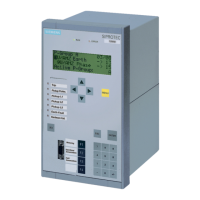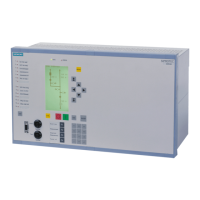Under and over-voltage protection (optional)
Voltage protection has the function of protecting electrical equipment against undervoltage and overvoltage.
Both operational states are unfavourable as overvoltage may cause, for example, insulation problems or
undervoltage may cause stability problems.
The overvoltage protection in the 7VK61 detects the phase voltages U
L1-E
, U
L2-E
and U
L3-E
, the phase-to-phase
voltages U
L1-L2
, U
L2-L3
and U
L3-L1
, as well as the displacement voltage 3U
0
. Instead of the displacement voltage
any other voltage that is connected to the fourth voltage input U
4
of the device can be detected. Furthermore,
the device calculates the positive sequence system voltage and the negative sequence system voltage so that
the symmetrical components are also monitored.
If there is only one voltage transformer in the system, the parameter 106 VT CONNECTION must be set
accordingly during configuration. Also, it is indispensable in this case that the secondary winding of the
voltage transformer is connected to the input U
L1
of the 7VK61.
The undervoltage protection can also use the phase voltages U
L1-E
, U
L2-E
and U
L3-E
, the phase-to-phase voltages
U
L1-L2
, U
L2-L3
and U
L3-L1
, as well as the positive sequence components.
These voltage protection functions can be combined according to the user's requirements. They can be
switched on or off separately, or used for alarm purposes only. In the latter case, the respective trip commands
do not appear. Each voltage protection function is dual-stage, i.e. it is provided with two threshold settings
each with the appropriate times delay.
Abnormally high voltages often occur e.g. in low loaded, long distance transmission lines, in islanded systems
when generator voltage regulation fails, or after full load shutdown of a generator with the generator discon-
nected from the system. Even if compensation reactors are used to avoid line overvoltages by compensation
of the line capacitance and thus reduction of the overvoltage, the overvoltage will endanger the insulation if
the reactors fail (e.g. due to fault clearance). The line must be de-energised within a very short time.
The undervoltage protection can be applied, for example, for disconnection or load shedding tasks in a
system. Furthermore, this protection scheme can detect impending stability problems. With induction
machines undervoltages have an effect on the stability and permissible torque thresholds.
Overvoltage Protection
Phase-to-earth overvoltage
Figure 2-25 depicts the logic diagram of the phase voltage stages. The fundamental component is numerically
filtered from each of the three measuring voltages so that harmonics or transient voltage peaks are largely
eliminated. Two threshold stages Uph-e> (address3702) and Uph-e>> (address 3704) are compared with the
voltages. If a phase voltage exceeds these thresholds, it is indicated in a phase-segregated way. In addition
there is a general pickup indication for each stage
Uph-e> Pickup
and
Uph-e>> Pickup
. The drop out to
pick up ratio can be set (Uph-e>(>) RESET (address3709)).
Every stage starts a time delay which is common to all phases. Expiry of the respective time delay T Uph-e>
(address3703) or T Uph-e>> (address3705) is signaled and normally results in the trip command
Uph-
e>(>) TRIP
.
The phase-to-earth overvoltage protection can be blocked via a binary input
>Uph-e>(>) BLK
.
2.5
2.5.1
Functions
2.5 Under and over-voltage protection (optional)
SIPROTEC 4, 7VK61, Manual 97
C53000-G1176-C159-5, Edition 05.2018

